CHEVROLET IMPALA 2010 9.G Workshop Manual
Manufacturer: CHEVROLET, Model Year: 2010, Model line: IMPALA, Model: CHEVROLET IMPALA 2010 9.GPages: 432, PDF Size: 1.89 MB
Page 51 of 432
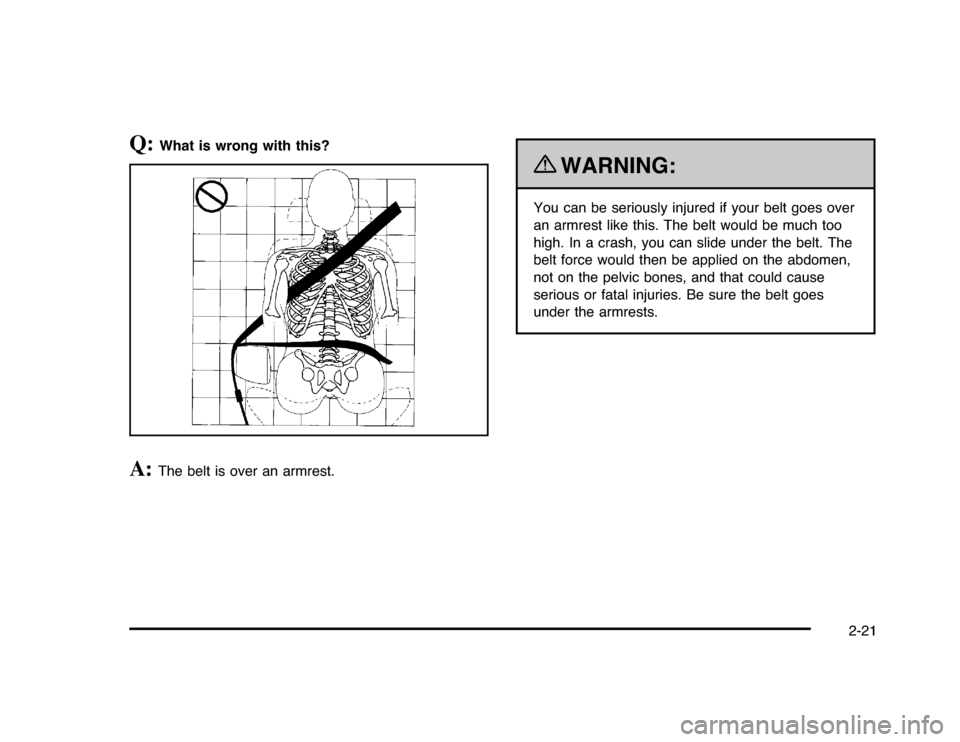
Q:
What is wrong with this?
A:
The belt is over an armrest.
{
WARNING:
You can be seriously injured if your belt goes over
an armrest like this. The belt would be much too
high. In a crash, you can slide under the belt. The
belt force would then be applied on the abdomen,
not on the pelvic bones, and that could cause
serious or fatal injuries. Be sure the belt goes
under the armrests.
2-21
Page 52 of 432
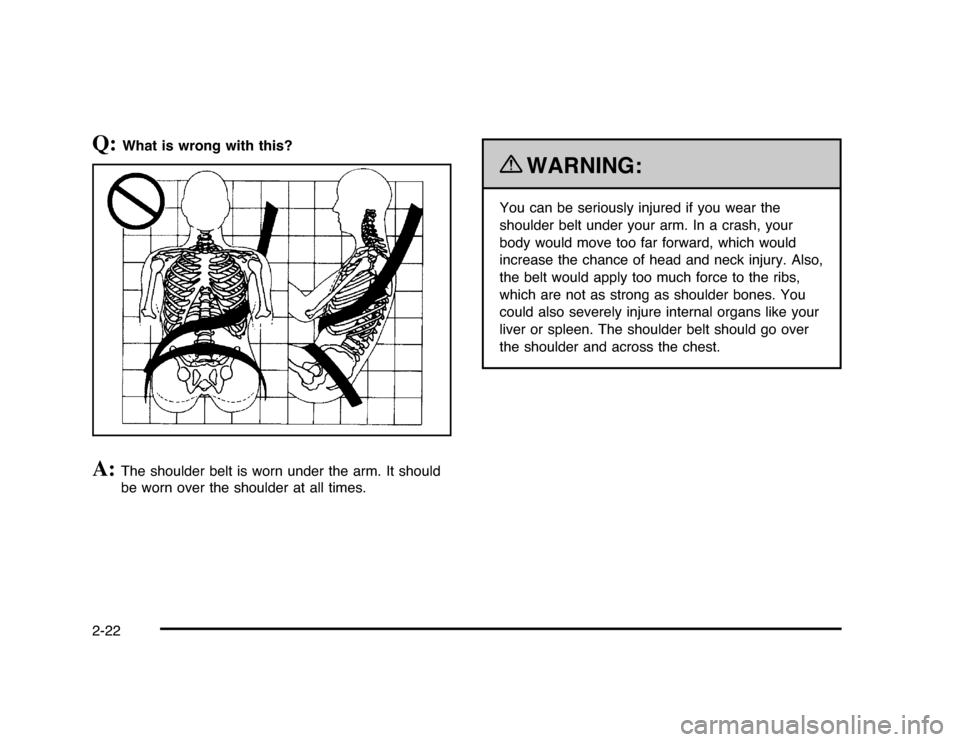
Q:
What is wrong with this?
A:
The shoulder belt is worn under the arm. It should
be worn over the shoulder at all times.
{
WARNING:
You can be seriously injured if you wear the
shoulder belt under your arm. In a crash, your
body would move too far forward, which would
increase the chance of head and neck injury. Also,
the belt would apply too much force to the ribs,
which are not as strong as shoulder bones. You
could also severely injure internal organs like your
liver or spleen. The shoulder belt should go over
the shoulder and across the chest.
2-22
Page 53 of 432
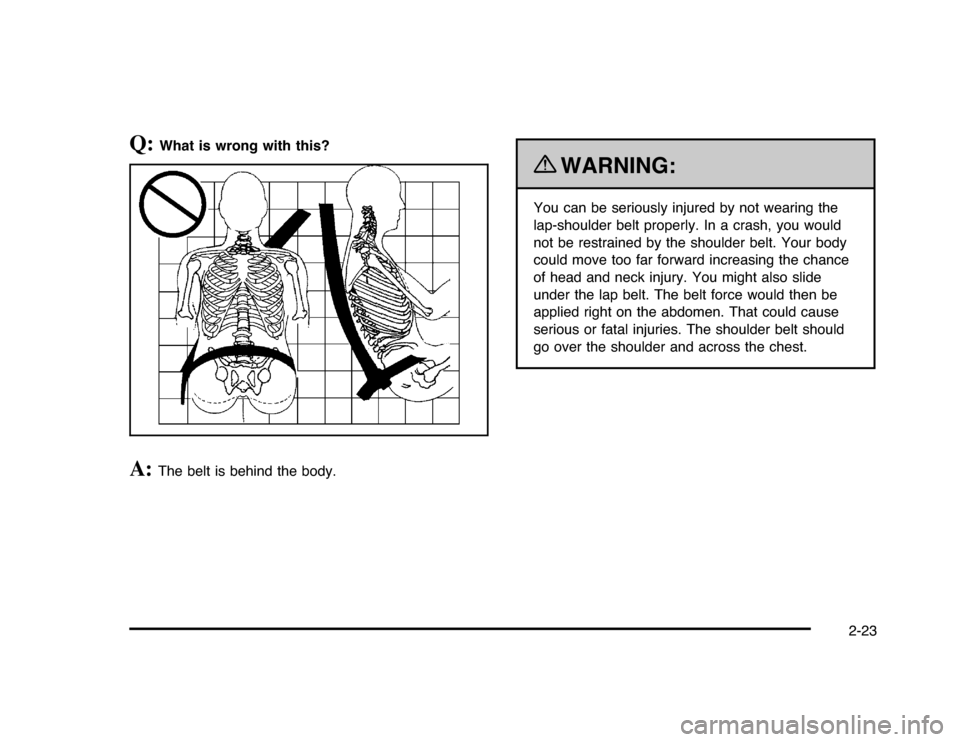
Q:
What is wrong with this?
A:
The belt is behind the body.
{
WARNING:
You can be seriously injured by not wearing the
lap-shoulder belt properly. In a crash, you would
not be restrained by the shoulder belt. Your body
could move too far forward increasing the chance
of head and neck injury. You might also slide
under the lap belt. The belt force would then be
applied right on the abdomen. That could cause
serious or fatal injuries. The shoulder belt should
go over the shoulder and across the chest.
2-23
Page 54 of 432
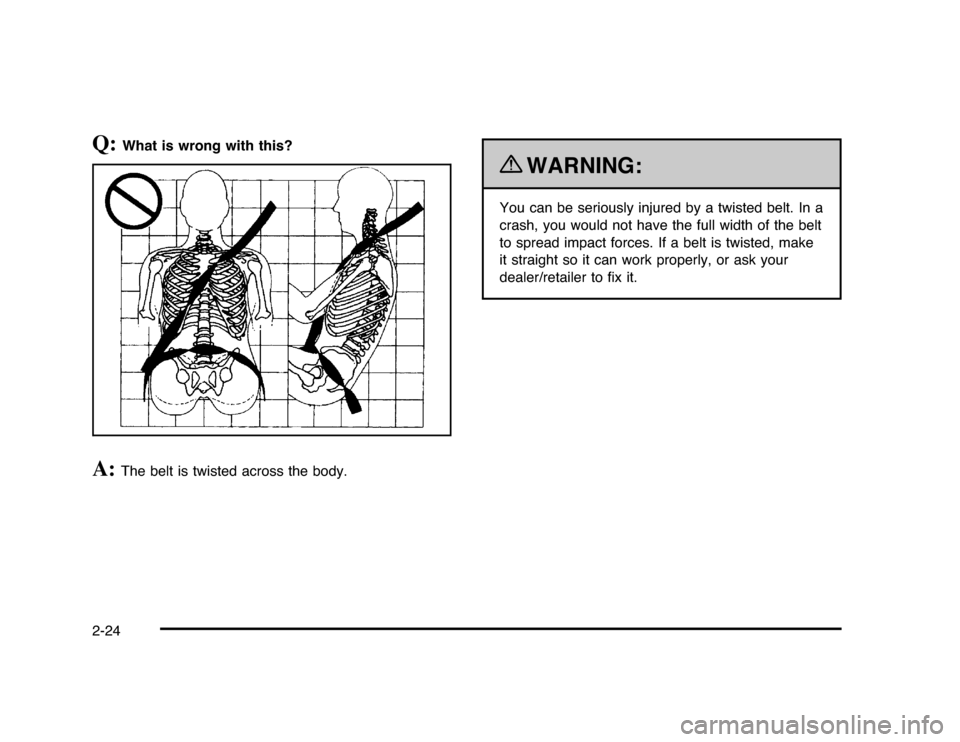
Q:
What is wrong with this?
A:
The belt is twisted across the body.
{
WARNING:
You can be seriously injured by a twisted belt. In a
crash, you would not have the full width of the belt
to spread impact forces. If a belt is twisted, make
it straight so it can work properly, or ask your
dealer/retailer to fix it.
2-24
Page 55 of 432
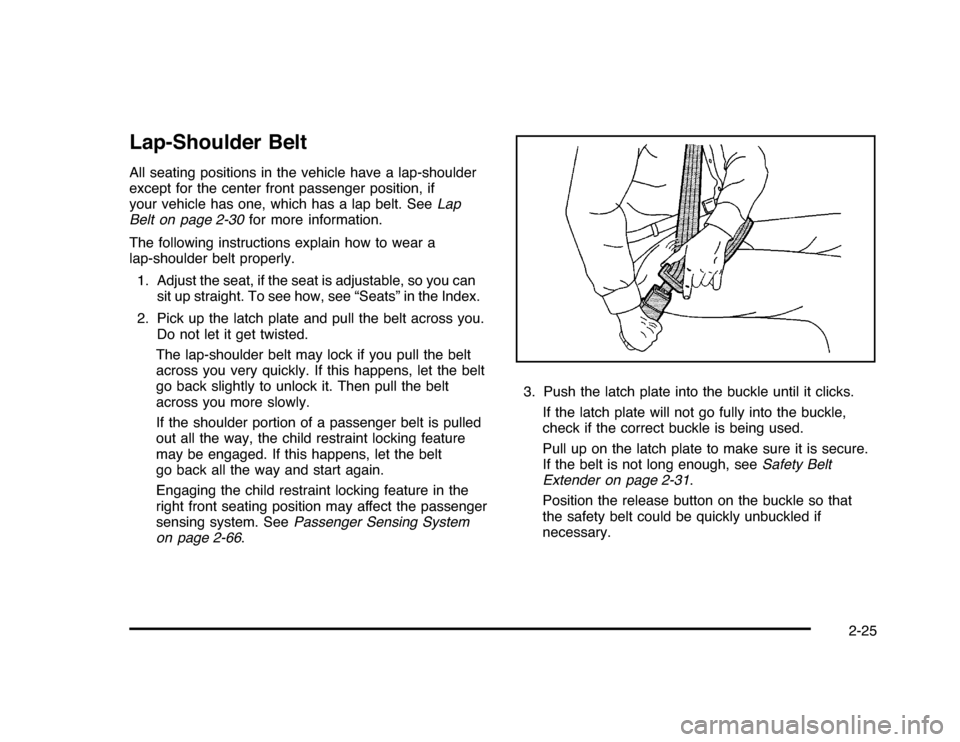
Lap-Shoulder BeltAll seating positions in the vehicle have a lap-shoulder
except for the center front passenger position, if
your vehicle has one, which has a lap belt. SeeLap
Belt on page 2-30for more information.
The following instructions explain how to wear a
lap-shoulder belt properly.
1. Adjust the seat, if the seat is adjustable, so you can
sit up straight. To see how, see “Seats” in the Index.
2. Pick up the latch plate and pull the belt across you.
Do not let it get twisted.
The lap-shoulder belt may lock if you pull the belt
across you very quickly. If this happens, let the belt
go back slightly to unlock it. Then pull the belt
across you more slowly.
If the shoulder portion of a passenger belt is pulled
out all the way, the child restraint locking feature
may be engaged. If this happens, let the belt
go back all the way and start again.
Engaging the child restraint locking feature in the
right front seating position may affect the passenger
sensing system. SeePassenger Sensing System
on page 2-66.3. Push the latch plate into the buckle until it clicks.
If the latch plate will not go fully into the buckle,
check if the correct buckle is being used.
Pull up on the latch plate to make sure it is secure.
If the belt is not long enough, seeSafety Belt
Extender on page 2-31.
Position the release button on the buckle so that
the safety belt could be quickly unbuckled if
necessary.
2-25
Page 56 of 432

4. If equipped with a shoulder belt height adjuster,
move it to the height that is right for you. See
“Shoulder Belt Height Adjustment” later in this
section for instructions on use and important safety
information.
5. To make the lap part tight, pull up on the
shoulder belt.
It may be necessary to pull stitching on the safety
belt through the latch plate to fully tighten the
lap belt on smaller occupants.To unlatch the belt, push the button on the buckle.
The belt should return to its stowed position.
Before a door is closed, be sure the belt is out of the
way. If a door is slammed against a safety belt, damage
can occur to both the safety belt and the vehicle.2-26
Page 57 of 432
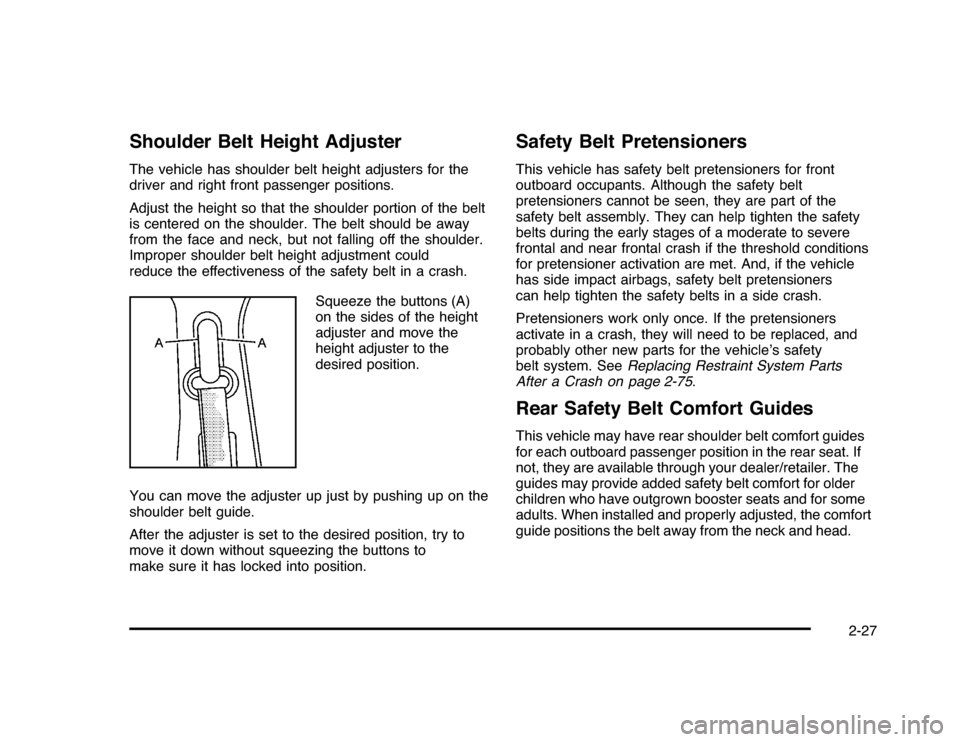
Shoulder Belt Height AdjusterThe vehicle has shoulder belt height adjusters for the
driver and right front passenger positions.
Adjust the height so that the shoulder portion of the belt
is centered on the shoulder. The belt should be away
from the face and neck, but not falling off the shoulder.
Improper shoulder belt height adjustment could
reduce the effectiveness of the safety belt in a crash.
Squeeze the buttons (A)
on the sides of the height
adjuster and move the
height adjuster to the
desired position.
You can move the adjuster up just by pushing up on the
shoulder belt guide.
After the adjuster is set to the desired position, try to
move it down without squeezing the buttons to
make sure it has locked into position.
Safety Belt PretensionersThis vehicle has safety belt pretensioners for front
outboard occupants. Although the safety belt
pretensioners cannot be seen, they are part of the
safety belt assembly. They can help tighten the safety
belts during the early stages of a moderate to severe
frontal and near frontal crash if the threshold conditions
for pretensioner activation are met. And, if the vehicle
has side impact airbags, safety belt pretensioners
can help tighten the safety belts in a side crash.
Pretensioners work only once. If the pretensioners
activate in a crash, they will need to be replaced, and
probably other new parts for the vehicle’s safety
belt system. SeeReplacing Restraint System Parts
After a Crash on page 2-75.Rear Safety Belt Comfort GuidesThis vehicle may have rear shoulder belt comfort guides
for each outboard passenger position in the rear seat. If
not, they are available through your dealer/retailer. The
guides may provide added safety belt comfort for older
children who have outgrown booster seats and for some
adults. When installed and properly adjusted, the comfort
guide positions the belt away from the neck and head.
2-27
Page 58 of 432

Here is how to install a comfort guide to the safety belt:
1. Pull the guide out from the pocket on the edge
of the seatback.
2. Place the guide over the belt, and insert the two
edges of the belt into the slots of the guide.3. Be sure that the belt is not twisted and it lies flat.
The elastic cord must be under the belt and the
guide on top.2-28
Page 59 of 432
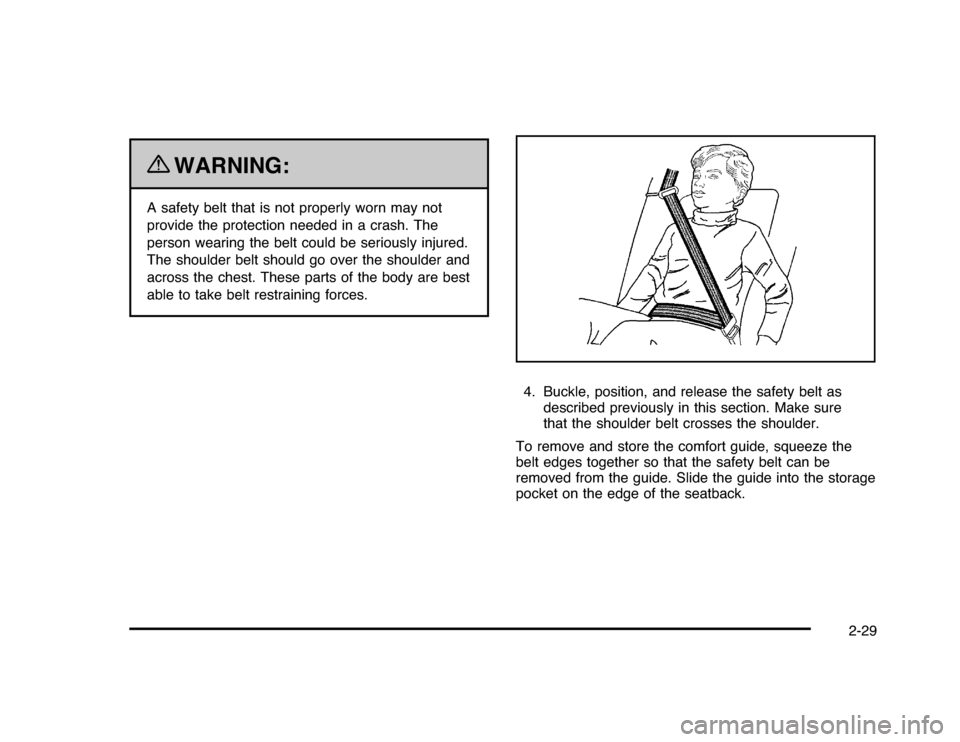
{
WARNING:
A safety belt that is not properly worn may not
provide the protection needed in a crash. The
person wearing the belt could be seriously injured.
The shoulder belt should go over the shoulder and
across the chest. These parts of the body are best
able to take belt restraining forces.
4. Buckle, position, and release the safety belt as
described previously in this section. Make sure
that the shoulder belt crosses the shoulder.
To remove and store the comfort guide, squeeze the
belt edges together so that the safety belt can be
removed from the guide. Slide the guide into the storage
pocket on the edge of the seatback.
2-29
Page 60 of 432
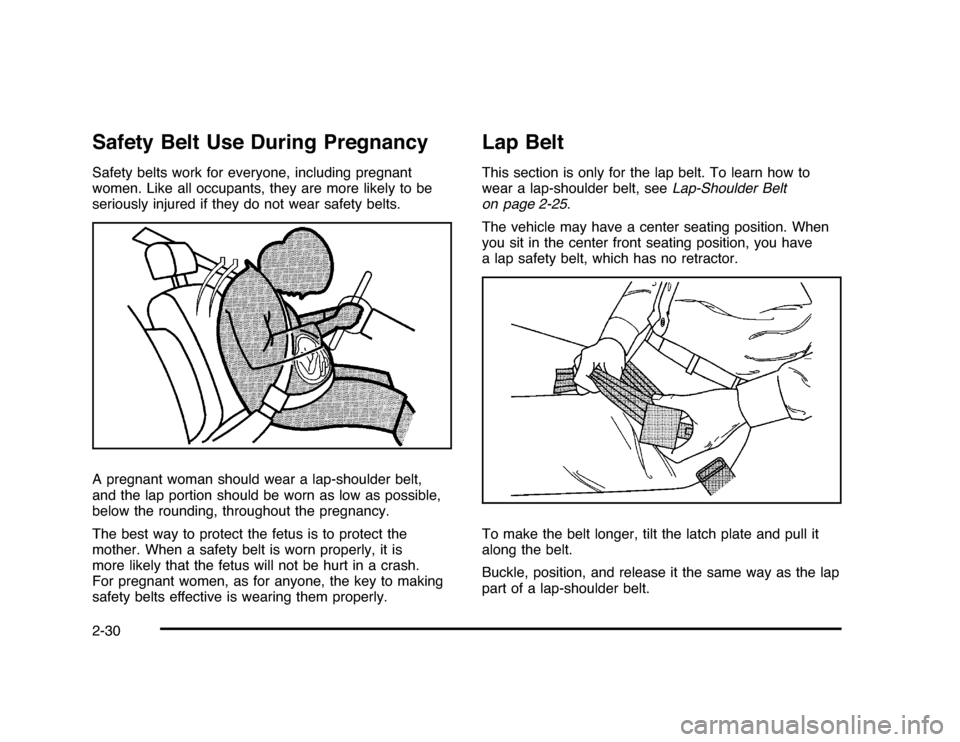
Safety Belt Use During PregnancySafety belts work for everyone, including pregnant
women. Like all occupants, they are more likely to be
seriously injured if they do not wear safety belts.
A pregnant woman should wear a lap-shoulder belt,
and the lap portion should be worn as low as possible,
below the rounding, throughout the pregnancy.
The best way to protect the fetus is to protect the
mother. When a safety belt is worn properly, it is
more likely that the fetus will not be hurt in a crash.
For pregnant women, as for anyone, the key to making
safety belts effective is wearing them properly.
Lap BeltThis section is only for the lap belt. To learn how to
wear a lap-shoulder belt, seeLap-Shoulder Belt
on page 2-25.
The vehicle may have a center seating position. When
you sit in the center front seating position, you have
a lap safety belt, which has no retractor.
To make the belt longer, tilt the latch plate and pull it
along the belt.
Buckle, position, and release it the same way as the lap
part of a lap-shoulder belt.
2-30